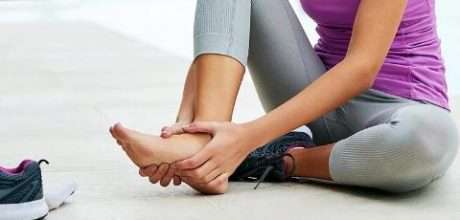There are many causes of pain in the foot and arch area and it’s one of the most restrictive bodily discomforts to live with. Pain in the arch of the foot is a common condition that can limit your walking and standing ability drastically. The arch of the foot, an area along the bottom of the foot between the ball and the heel, is made up of three separate arches that form a triangle and consists of bones, ligaments, and tendons. There are many causes but here are a few common, easily treatable conditions:
1.#Plantar fasciitis is a degenerative condition of the plantar fascia and a common cause of heel pain, especially among athletes. The plantar fascia is a ligament that connects the back of the foot to the front.
Common causes of plantar fasciitis include:
- Injury
- Overuse
- Inflammation
- Aging
- Physical stress
- Neurological conditions
- Weight gain
- Structural issues
2.#Overpronation refers to how a person’s foot moves while walking, running, or jogging. This type of foot movement strikes the ground with the outer portion of the heel first, then rolling too far onto the arch. The extra pressure causes the arch to flatten.
Long term, overpronation can damage tendons, muscles, and ligaments. This damage can lead to pain in various parts of the body namely, the arch, knee, hip, or back. It may also cause hammertoes, and calluses.
A person who overpronates often benefits from extra support such as stability shoes and prescription arch supports when walking or running.
3.#Posterior tibial tendon dysfunction occurs when this tendon is inflamed or injured causing lack of support in the arch area. Walking or running will cause this pain to manifest.
#Flat feet are very common in children as well as adults and can easily be helped to avoid back pain, arch pain as well as knee and ankle pain.
Seeing your Physical Therapist first to correctly diagnose your condition is an important first step. Once the condition has been isolated there are many wonderful stretches and exercises you can do to improve your quality of walking and lessen the pain. Once your Physical Therapist has worked with you a few times you will be able to continue these exercises at home.
Here are a few helpful tips that may help you until you get to see your #Physical Therapist:
A. Stretching the calf:
- lean your hands against a wall
- straighten the knee of the affected leg and bend the other knee in front
- keep both feet flat on the ground
- there should be a stretching sensation in the heel and calf of the extended leg
- hold for 10 seconds (if really uncomfortable) progress to 2 min holds.
- repeat two to three times for shorter holds and once for 2 min holds
B. Rolling the foot – Placing a round object under the foot and rolling back and forth can help loosen up the foot muscles. People can use a rolling pin, golf ball, or specialized foam roller for this. Use the following steps to stretch the foot:
- Remove your shoes
- sit tall on a chair
- roll a round object under the arch of the foot eg. a foam ball or small tennis ball
- roll for 2 minutes
Please don’t hesitate to call us at @Jason Ferine Physical Therapy in West Los Angeles and we will do our best to advise and help you. If the pain persists, gets worse, or is chronic, a person should talk to their doctor about additional treatment options in addition to Physical Therapy.
2300 Westwood Blvd STE. 100,
Los Angeles , CA 90064
TELEPHONE: 424 365 2083
FAX: 310 943 3532
EMAIL: jfptoffice@gmail.com
REF:
American Orthopaedic Foot & Ankle Society. http://www.choosingwisely.org/clinician-lists/american-orthopaedic-foot-ankle-society-surgery-for-plantar-fascitis-before-six-months-nonoperative-care/
Hansen, L., et al. (2018). Long-term prognosis of plantar fasciitis: A 5- to 15-year follow-up study of 174 patients with ultrasound examination. https://www.ncbi.nlm.nih.gov/pmc/articles/PMC5844527/



